INSTRUCTIONS TO CANDIDATES
- Write your name and index number in the spaces provided above.
- Sign and write the date of examination in the spaces provided above.
- This paper consists of Two sections A and B.
- Answer ALL the questions in section A in the spaces provided.
- In section B answer question 6 (compulsory) and either 7 or 8 in the spaces provided.
FOR EXAMINERS USE ONLY.
|
SECTION |
QUESTIONS |
MAXIMUM SCORE |
CANDIDATE’S SCORE |
|
A |
1 |
8 |
|
|
2 |
8 |
||
|
3 |
8 |
||
|
4 |
8 |
||
|
5 |
8 |
||
|
B |
6 |
20 |
|
|
7 |
20 |
||
|
8 |
20 |
||
|
TOTAL |
80 |

QUESTIONS
SECTION A (40 MARKS)
Answer all the questions in the spaces provided.
- Study the diagram below and answer the questions that follow
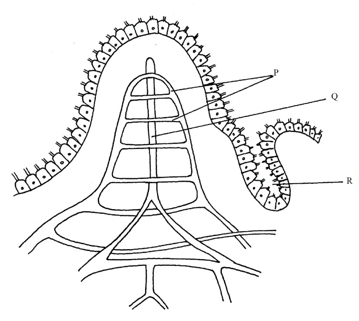
- Identify the structure (1mks)
- State the role of the part labelled R (1mk)
- A student took a meal of lean meat. Briefly describe the digestion of the food substance where this structure is found (3mks)
- What is the role of the following: enterokinase and cholecystokinin in digestion? (2mk) Enterokinase.....................................................................................
cholecstokinin:.................................................................................. - State the deficiency disease associated with lack of vitamin B2 (1mk)
-
-
- The diagram below represents the anterior view of a certain mammalian vertebra
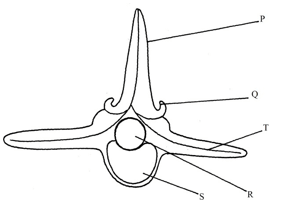
- Name the part labelled Q (1mk)
- Describe three adaptations of the above vertabra to its function function (3mks)
- The diagram below represents the anterior view of a certain mammalian vertebra
- State the role of the part of the brain called Medulla oblongata (1mk)
- State the effects of under secretion of thyroxine hormone (hypothyroidism) (2mks)
-
-
- Define the following terms as applied in genetics
- Genetic engineering (1mk)
- Biotechnology (1mk)
- In a family of four children, the father had blood group A while the mother had blood group B. One of the children had blood group O. The father wanted to commit suicide accusing his wife of infidelity?
- Was this accusation justified? (1mk)
- With the use of a punnet square work out the genotype of other children. (3mks)
- Explain why haemolytic disease of the new born (Erythroblastosis foetalis) is encountered in children born later in a family where the mother is Rhesus negative and the father is Rhesus positive (2mks)
- Define the following terms as applied in genetics
- The diagram below shows how gaseous exchange occurs across the gills in fish.
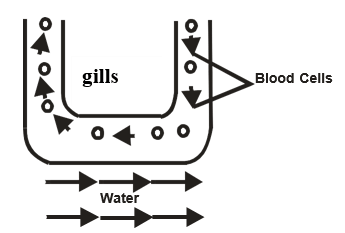
- Explain the advantage of the above flow named in a(i) above. (1 Mk)
- If the fish is removed from water it dies immediately. Explain why (2mks)
- Explain mechanism of gaseous exchange in frog through the skin (5mks)
- In mammals haemoglobin is confined to red blood cells. Give one advantage of this (1mk)
- The diagram below show the structure of an organism. Study it and answer the questions that follows.
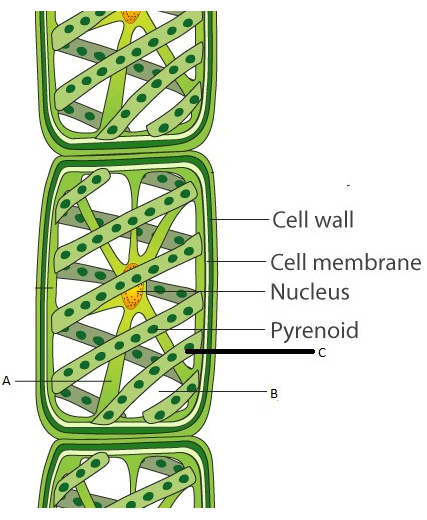
-
- Name the parts labelled and Aand B (2mks)
A:.........................................................................................................................................................
B :............................................................................................................................................................. - State the role of part labeled C (1mk)
- Name the parts labelled and Aand B (2mks)
- State the kingdom to which the organism belong (1mk)
- State the economic Importance of the organism in this Kingdom (1mks)
-
- state the causative agent of syphilis (1mk)
- State one of the symptoms of the disease (1mk)
- State the role of sertoli cells in reproduction (1mk)
-
SECTION B (40 MARKS)
Answer question 6(compulsory) and either question 7 or 8
- The data below was obtained during ecological study in grassland
organism
Dry mass mg/m3
Primary producers
1600
Primary consumers
400
Secondary consumers
120
Tertiary consumers
8
- Using the same grid provided draw a pyramid of biomass for the data above (6mks)
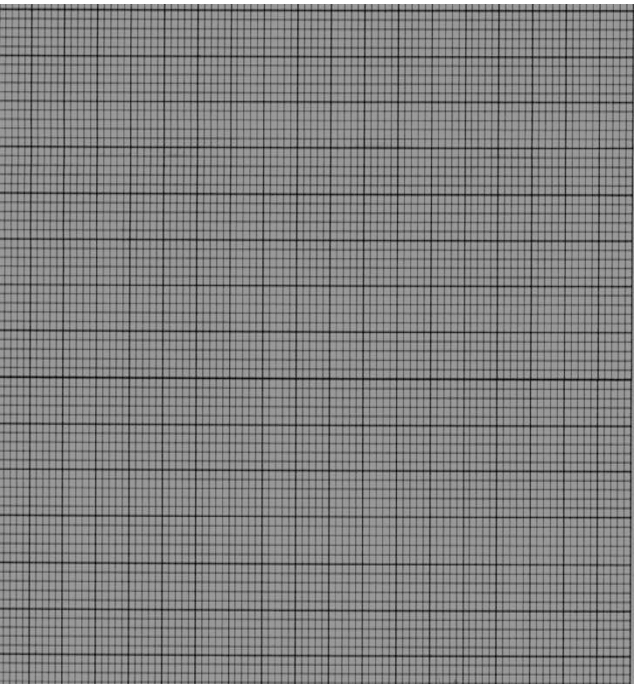
- Account for the shape of the pyramid of biomass (4mks)
-
- Explain why pyramid of numbers on data obtained from a forest ecosystem differs from the data above (2mks)
- state on importance of ecological pyramids (1mk)
- Describe how you would use 1m2 quadrat to investigate changes in frequency of the grass population over a period of five years (4mks)
- In what form will you present your results in (d) above ? (1mk)
- State any two limitations of using quadrat to study populations (2mks)
- Name the instrument that is used to measure light penetration in water (1mk)
- Using the same grid provided draw a pyramid of biomass for the data above (6mks)
-
- describe the role of gibberellins in plant growth and development (3mks)
- State two roles of metamorphosis in insects (2mks)
- Describe the process of secondary growth in flowering plants (15mks)
- Nyambura hears roar of a lion then runs away for safety. Describe how she heard the roar and what happened in the nervous and endocrine systems that made her run away. (20mks)

Marking scheme
- Study the diagram below and answer the questions that follow

- Identify the structure (1mks)
- Villus; (rej. Wrong spp or villi)
- State the role of the part labelled R (1mk)
- Secrete mucus with an alkaline pH which protects ileum from corrosion by enzymes/serves to neutralize chyme from the stomach;
- A student took a meal of lean meat. Briefly describe the digestion of the food substance where this structure is found. (3mks)
- Arrival of chyme in the ileum stimulates secretion of intestinal juice/succus entericus; which mixes with the food; It contains peptidase which breaks down peptides into amino acids;
- What is the role of the following: enterokinase and cholecystokinin in digestion? (2mk)
- Enterokinase: Activates inactive trypsinogen to active form trypsin; cholecystokinin:.causes gall bladder to release bile juice into duodenum; stimulates the pancreas to secrete pancreatic enzymes (reject without terms like stimulate/causes);
- State the deficiency disease associated with lack of vitamin B2 (1mk)
- pellagra; (rej wrong spp).
- Identify the structure (1mks)
-
-
- The diagram below represents the anterior view of a certain mammalian vertebra

- Name the part labelled Q (1mk)
- Prezygapophysis; (jej. Wrong spp)
- Describe three adaptations of the above vertabra to its function function (3mks)
- Has a broad neural spine that provides a large surface for attachment of abdominal muscles;
- Has a large and broad centrum for supporting the upper body weight;
- Has broad and long transverse processes to offer a large surface area for muscle attachment;
- Has projections called metapophyses for increasing the surface area for attachment of muscles;
- Has pre- and post-zygaphyses for atticulation with adjacent vertebrae; Has neural arch and centrum for protection of spinal cord;
- The diagram below represents the anterior view of a certain mammalian vertebra
- State the role of the part of the brain called Medulla oblongata (1mk)
- Controls involuntary activities such as breathing, swallowing, salivation, vomiting; (acc. any one)
- Influence blood pressure by controlling dilation and constriction of blood vessels;
- State the effect of under secretion of thyroxine hormone (hypothyroidism) (2mks)
- It causes cretinism in children;
- and myxoedema in adults;
-
-
- Define the following terms as applied in genetics
- Genetic engineering (1mk)
- This deals with identification of desirable genes, altering, isolating and transferring it from one organism to another; (all terms to be there to earn).
- Biotechnology (1mk)
- A branch of biology which deals with the development of techniques for application of biological processes;
- Genetic engineering (1mk)
- In a family of four children, the father had blood group A while the mother had blood group B.One of the children had blood group O.The father wanted to commit suicide accusing his wife of infidelity?
- Was this accusation justified? (1mk)
- Not justified to his claim. If the genotype of father is AO and that of the mother is BO then one of the offspring must be OO;
- With the use of a punnet square work out the genotype of other children. (3mks)
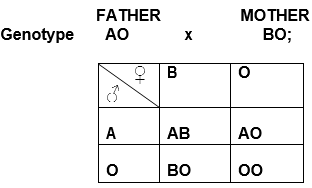
- Was this accusation justified? (1mk)
- Explain why haemolytic disease of the new born (Erythroblastosis foetalis) is encountered in children born later in a family where the mother is Rhesus negative and the father is Rhesus positive (2mks)
- Rhesus antigens from the foetus cross the placenta into the maternal blood stream. The mothers immune system produces Rhesus antibodies. The first born child if rhesus positive is without problems since the mother’s immune system produces rhesus antibodies rather slowly; The second Rh+ve foetus encounters more Rhesus antibodies which cause more damage to foetal red blood cells leading to haemolytic disease of the newborn;
- Define the following terms as applied in genetics
- The diagram below shows how gaseous exchange occurs across the gills in fish.

- Explain the advantage of the above flow named in a(i) above. (1 Marks)
- Maintains a steep concentration gradient ensuring efficient gaseous exchange;
- If the fish is removed from water it dies immediately. Explain why (2mks)
- Fish uses dissolved oxygen for gaseous exchange; gill filament epithelium dries up; gill filaments clamp together; surface area for gaseous exchange is reduced; oxygen lacks moist surface for dissolution causing death (due to suffocation)
- Explain mechanism of gaseous exchange in frog through the skin (4mks)
- The frog has a thin and moist skin; Oxygen dissolves in the moisture and then diffuses through the skin;. There is a dense network of blood capillaries beneath the skin which transport the diffused gas/oxygen into the body tissues;. Carbon (IV) oxide in the blood diffuses out of the blood capillaries through the moist skin into the surrounding water and air;
- In mammals haemoglobin is confined to red blood cells. Give one advantage of this (1mk)
- If haemoglobin were dissolved in plasma, the osmotic pressure of blood would increase considerably. This would interfere with other physiological processes;
- If haemoglobin were dissolved in plasma, the viscosity of blood would considerably. This would require the heart to work much harder to pump blood throughout the body;
- Explain the advantage of the above flow named in a(i) above. (1 Marks)
- The diagram below show the structure of an organism. Study it and answer the questions that follows

-
- Name the parts labelled and Aand B (2mks)
- A:strand of cytoplasm (crossing vacuole)
- B :vacuole
- state the role of part labeled as C
- has chlorophyll that trap light energy for photosynthesis
- Name the parts labelled and Aand B (2mks)
- State the kingdom to which the organism belong (1mk)
- Protoctista
- State the economic Importance of the organism in this Kingdom (1mks)
- Some organism cause animal diseases e.g trypanosomes, amoeba, malaria; Food for fish like spirogyra;
-
- state the causative agent of syphilis (1mk)
- Treponema pallidum
- State one of the symptoms of the disease (1mk)
- Painless lesions on glans of penis/vaginal walls/ lips; Rashes or mucus patches;
- Macules/discoloured spots and papules/ pimples on the skin may appear on hands,feet, oral cavity,lips and genital areas;
- Systematic affecting various organs in the body; Insanity when menenges attacked;
- state the role of sertoli cells in reproduction (1mk)
- provide nourishment to the developing sperms as they mature;
- state the causative agent of syphilis (1mk)
-
- The data below was obtained during ecological study in grassland
organism
Dry mass mg/m3
Primary producers
1600
Primary consumers
400
Secondary consumers
120
Tertiary consumers
8
- Using the same grid provided draw a pyramid of biomass to scale for the data above (6mks)

Scale=1mk
Labeling of axes:1mk
Each trophic level correctly drawn: (4mk)
Total= 6mks - Account for the shape of the pyramid of biomass (4mks)
- The pyramid has a very wide base; due to the large biomass of primary producers; biomass decreases from one trophic level to the next;. Biomass is least at tertiary consumers level and at apex. The pyramid tapers towards the apex; Primary producers are green plants which trap and use sunlight to make food for photosynthesis. Other organisms depend on them for food; some energy is lost through respiration; Primary consumers are herbivores/they eat green plants. Their biomass is less than primary than primary producers; energy is lost through excretionor defaecation; besides respiration as with secondary and tertiary consumers. Secondary consumers are first level carnivores, which eat primary consumers; their biomass decreases further; Tertiary consumers feed on secondary consumers and have the lowest biomass;
-
- Explain why pyramid of numbers on data obtained from a forest ecosystem differs from the data above (1mks)
- Number of producers are fewer than consumers. Trees are bigger in size and several organisms depend on them;
- State one importance of ecological pyramids (1mk)
- are useful in comparing different ecosystems;
- they show seasonal variations in an ecosystem;
- they show change in the components of an ecosystem;
- Explain why pyramid of numbers on data obtained from a forest ecosystem differs from the data above (1mks)
- Describe how you would use 1m2 quadrat to investigate changes in frequency of the grass population over a period of five years (4mks)
- study area is selected; marked with pegs and area measured; while at the middle a 1mx 1m quadrat is thrown randomly in the quadrat;
- Number the plants in the boundaries of the quadrat is counted and recorded; The throws are done repeatedly each time recording the number of plants;
- The average plant population per quadrat is calculated and recorded; this value is used to infer and calculate the total plant population in the study area;
- In what form will you present your results in (d) above (1mk)
- Bar graphs; line graphs ;pie chart; histograms (any One)
- State any two limitations of using quadrat to study this population (2mks)
- cannot be used for large sized organisms;
- randomness of the samples may not be assured depending on the method of tossing the quadrat thus danger of overestimating or underestimating;
- tedious and time consuming especially if large area is to be covered; only suitable for stationary or less mobile organisms;
- Name the instrument that is used to measure light penetration in water (1mk)
- Secchi disc; (rej wrong spp)
- Using the same grid provided draw a pyramid of biomass to scale for the data above (6mks)
-
- Role of gibberellins
- Stimulates rapid cell division and cell elongation in dwarf varieties;
- Induce growth of ovaries into fruit after fertilization/fruit formation;
- Induce parthenocarpy;
- Promotes formation of side branches from lateral buds/ break dormancy in buds;
- Inhibits sprouting of adventitious roots from stem cuttings;
- Retards formation of abscission layer hence reduce leaf fall;
- Breaks seed dormancy; ( by activating enzymes involved in breakdown of food substances during germination)
- Role of metamorphosis
- reduces competition for food between pupa and adults;
- it enables insects to overcome adverse weather conditions; it helps in dispersal of various insect species;
- enables a species to exploit two or more ecological niches during its lifecycle, thus increase chances of survival;
- Secondary thickening
- It is a process that occur due to activity of cambium meristems; hence results into increase in width/girth of stem; the process starts with division of vascular cambium to cambium ring; cambium ring divide to form new cells; the cells that are formed on outer side of cambium ring are differentiated to form secondary phloem; while the cells that are formed on inner side of cambium ring are differentiated to form secondary xylem; more secondary xylem are formed than secondary phloem; intervascular cambium cuts off parenchymatous cells to form secondary medullary rays; as a result of increase in the volume of secondary tissue; pressure is exerted on outer cells of stem; resulting in stretching and rupturing of epidermal cells; in order to replace the protective outer layer of stem, new band of cambium cells are formed in the cortex; these cells are called cork cells/phelogen; the cork cambium divide to produce new cells on either side; the cells on inner side of cork cambium are differentiated into secondary cortex; while those on outer side are differentiated to form cork cells; the cork cells increases in number in bark of stem; in some woody plants the cork cells are loosely packed forming lenticels; which permits gaseous exchange to take place; the rate of secondary growth in a stem varies with seasonal changes; during rainy season, more xylem and tracheids are formed; the cells are large and have thin walls; and wood has light texture; during dry period a few xylem and tracheids are formed; the cells are small; thick walled; and wood has dark texture; this leads to the development of two distinctive layers within the secondary xylem formed in a year called annual rings; it is possible to determine the age of a tree by counting the number of annual ring;
- Role of gibberellins
- Nyambura hears roar of a lion then runs away for safety. Describe how she heard the roar and what happened in the nervous system that made her run away (20mks)
- The pinna concentrates sound waves; from roaring lion into auditory meatus; the sound waves strike the eardrum; and cause it to vibrate; the vibrations are transmitted to the ear ossicles in the middle ear; from the ear drum. The vibrations are picked by the first ear ossicles; the malleus; which transmits to the incus; up to the stapes; the stapes passes the vibrations to oval window from where the vibrations are transmitted to the perilymph of the cochlea; The three ear ossicles are specially arranged to amplify the vibrations; as they transmit them to oval window; In the cochlea the vibrations stimulate the sensory hairs to generate nerve impulses which transmitted to the brain via auditory nerve; for interpretation as dangerous; Impulses from the brain are transmitted to (adrenal medulla) of adrenal glands; to produce adrenaline hormone; which prepares the body for emergency/flight. It causes increased heartbeat; increased rate of circulation; increases metabolic rate; arterioles to the skin and digestive system constrict; (diverting blood from alimentary canal and skin to skeletal muscles);dilation of the pupil; glycogen is converted to glucose in the liver; skeletal muscles contract and relax which can allow movement; breathing rate becomes faster; fats converted to fatty acids which are available in the blood for muscle contraction;. These changes increases energy production especially in skeletal muscles and prepares the body for sudden flight;
Download Biology P2 Questions and Answers - Momaliche 4 cycle Post Mock Exams 2021/2022.
Tap Here to Download for 50/-
Get on WhatsApp for 50/-
Why download?
- ✔ To read offline at any time.
- ✔ To Print at your convenience
- ✔ Share Easily with Friends / Students

